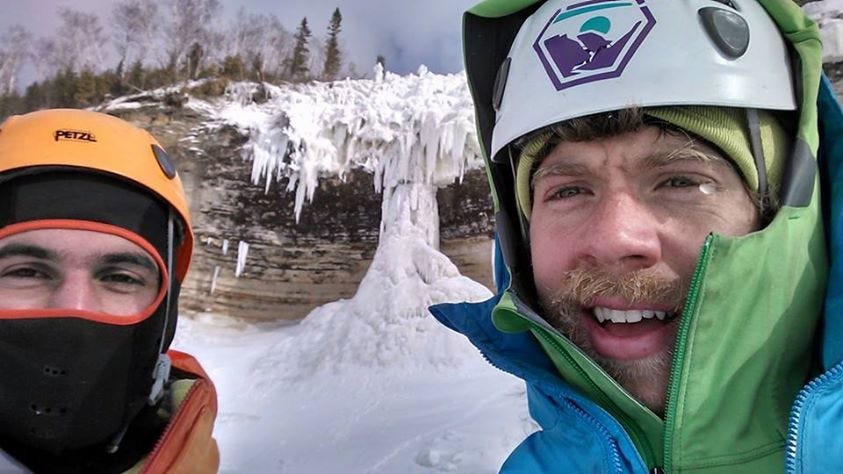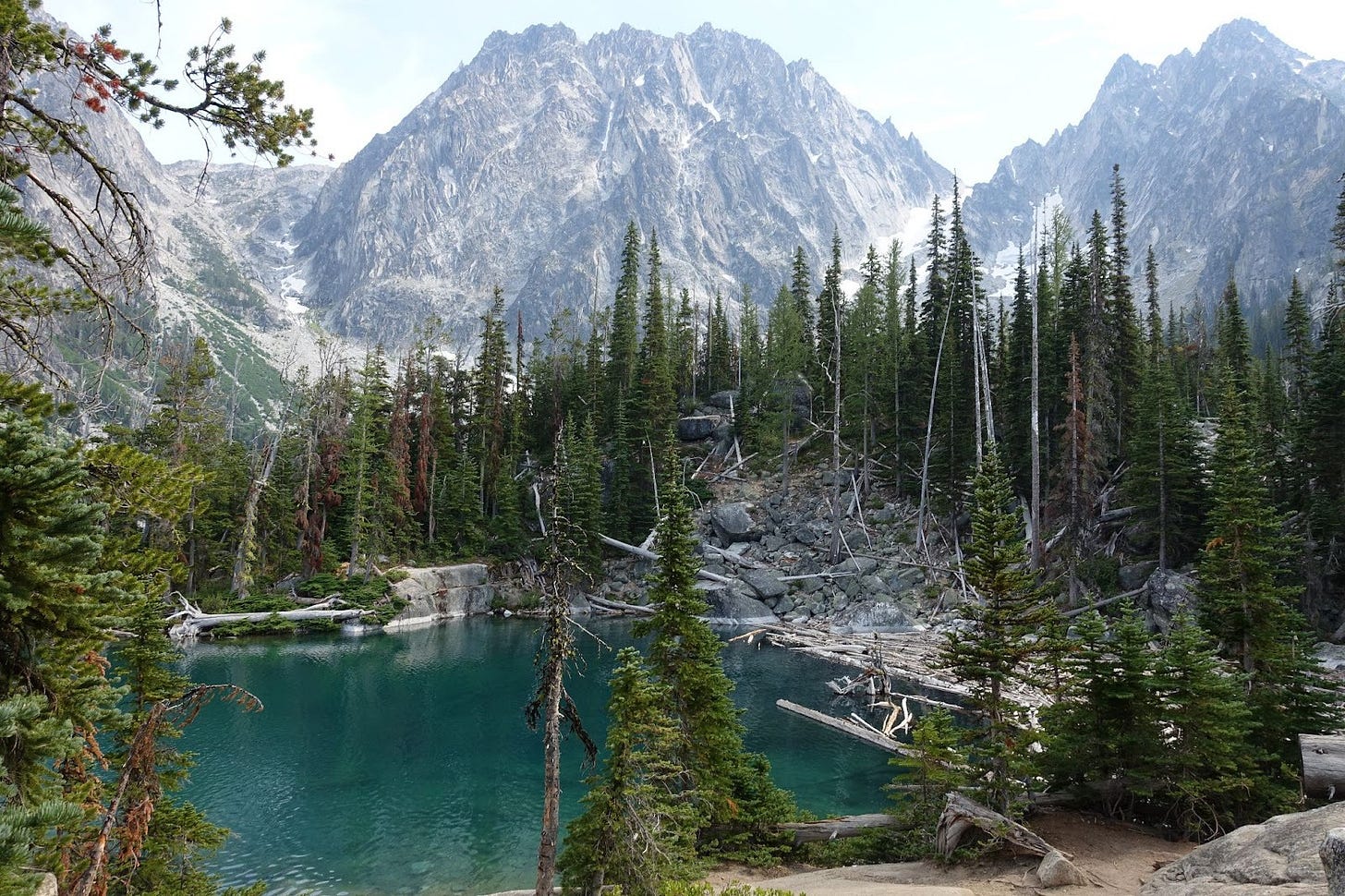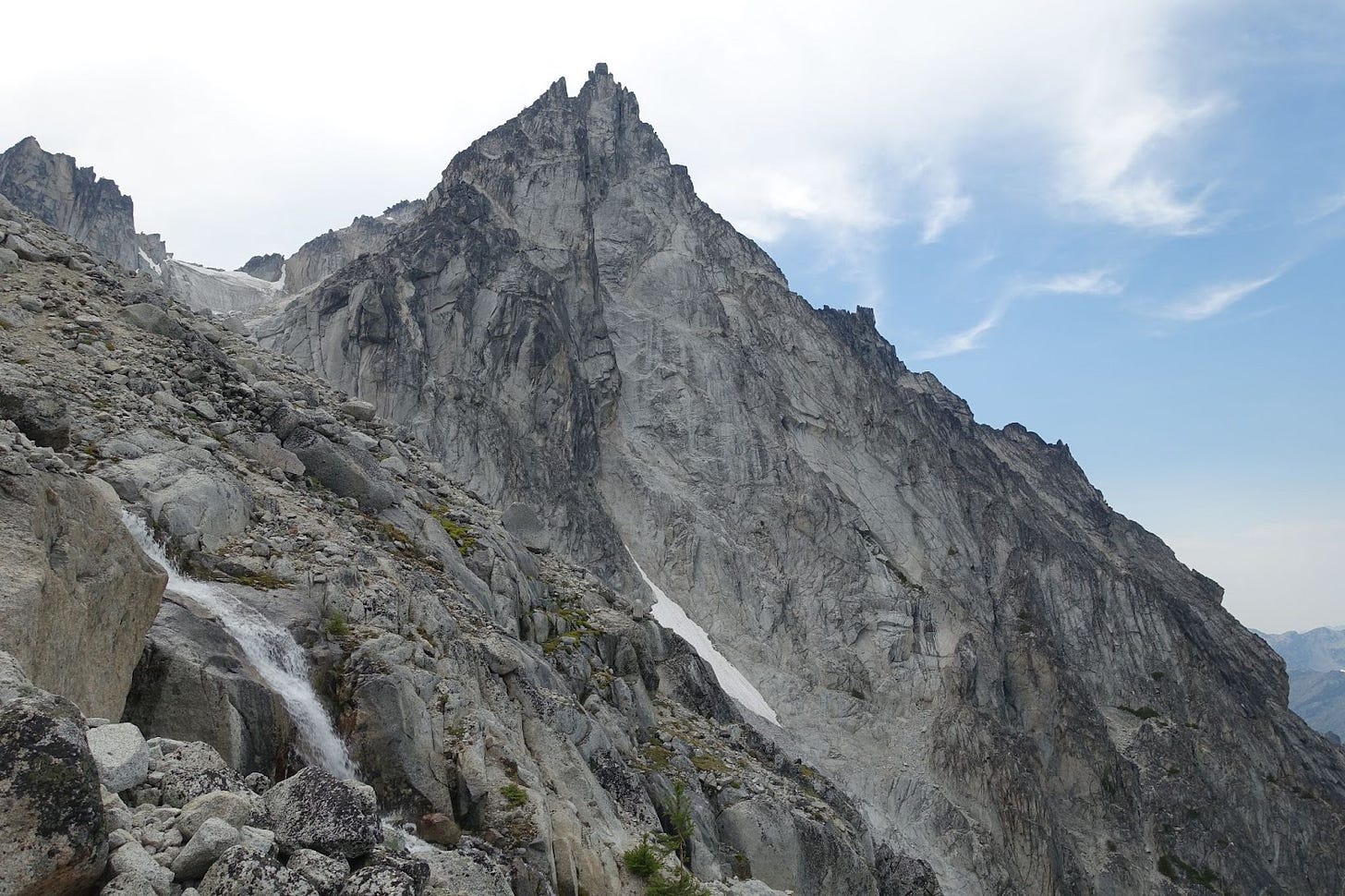The university I attended owned a cabin close to Franconia Notch, New Hampshire, known to many outside the state as ‘the place where the old man in the mountain once was’. The cabin has always been active as a basecamp for adventure, but particularly from 2009 through 2018, when a group of Boston-area alumni and students, self-proclaimed ‘Vertical Ice Climbing Enthusiasts’ (VICE) ruled the roost. Led by one boisterous man nicknamed JLo, the group snowballed into a great run of ice climbing festivals (i.e. VICEfests) which melded ice climbing and outrageous parties. The university administration caught on in 2019 and shut it down. But 1500 people learned to ice climb in the interim, so I say good on JLo.
I was one of those people. In 2010 (my second year at university), I made a new friend in my job as a resident assistant. My friend’s name was Dan, and he was a glowing, energetic personality. Dan and I became close over that fall, and he was very excited to try ice climbing that winter. So during our winter break, I climbed ice for the very first time with the VICE crew. In fact, it was the first time I climbed, period. We took a bunch of photos that day, and Dan made a Facebook album that I’m happy to have screenshotted before I deleted my Facebook — “No More Global Warming”.
After that day, ice climbing and by extension alpinism (climbing mountains via technical routes with a mixture of rock, ice, and snow), became a fixture in my life. I selected a graduate school partly based on its proximity to great ice, and became a student of the craft by reading guidebooks, training manuals, and histories of the sport. I spent lots of time climbing with Dan and other friends. From that wealth of experiences, being an ‘alpine climber’ was, is, and will forever be an identity I associate with.
During the time I pursued alpine climbing with the most vigor (2014 through 2018), Dan was more focused on his career and community, an election I respected. He worked his way through several big tech companies, precisely engineering tiny components for ever smaller phones and watches. Whenever we spoke, he’d tell me another step he’d taken toward his philosophy of ideal design, captured by Antoine de Saint-Exupéry, “Perfection is achieved, not when there is nothing more to add, but when there is nothing left to take away.” Every time he’d visit Colorado, he’d insist on replacing his friend’s phones with the newest and best version of his handiwork.
He’d also share how his Chicago Jewish community was developing in a rich and wonderful way. He joined (started?) a Moishe House chapter. Dan told me he wanted people to feel welcome to join in the fun. A website for “Jews in the Loop” describes it well: “Daniel has really made his mark on the community by designing meaningful Jewish programs and experiences through Moishe House. A former resident of Old Town Moishe House, Daniel organized Shabbat dinners, programs and special trips. Uniquely, he helped Moishe House build partnerships with for-profit businesses, especially ones that tie into his passion for outdoor adventure and rock-climbing.” This photo describes it better:
In 2018, I broke my right femur. It healed an inch short and for years I struggled with that discrepancy. In something like a tide of life, Dan started training hard for climbing about when I first got injured. He was methodical, spending hours at the rock gym to get ready for outdoor climbing. Chicago has about 25 feet of natural elevation gain — so he turned the rock gym into his mountain simulator, climbing laps on the autobelay for endurance, adding layers for heat, adding weight to compensate for the water and food he’d carry. His methodology is well captured in this blog post. And though he had a high-pressure job and a busy training calendar, Dan still showed up for me. He would pick up the phone whenever I called. He would come to visit me in Colorado, and choose crags with easy approaches. He was happy joining me in mild activities that didn’t bring me discomfort, like mellow skate skiing and nature walks.
Dan moved to Seattle in late 2020, brimming with excitement for life in a city near the mountains. He was especially excited about the alpine climbing opportunities nearby. In December 2020, I started the process of lengthening my femur and was off my feet for about six months. We chatted on the phone every couple months during that time — I was on my way to symmetry, and had thoughts of a possible return to alpinism, while Dan was getting ready for a big alpine season during the Cascadian summer.
On Friday, May 25th 2021, Dan called me and I silenced it because I was working. He was about to head out on a climbing trip for the Memorial Day weekend. I figured I’d talk to him the following week.
I know the following from an accident report I wrote later that month:
“On Saturday, May 26th, Dan Meer and some friends including his climbing partner, met up and went for a sail on Puget Sound; it was a beautiful day, they saw pods of orcas and caught up on life. After sailing, Dan and his partner parted ways for a few hours before meeting up at 8 PM to depart for the Enchantments, a range of granitic peaks in Central Washington State. The next day they planned to climb the Serpentine Arete on Dragontail Peak.
They arrived at the Colchuck Lake trailhead at around 11 PM and slept in the car until 4 AM. They woke up, ate Dan’s favorite morning snack (instant oatmeal and an entire banana in just two bites), made some last minute decisions on climbing gear, then set off hiking up the trail at 5 AM.
They arrived at the base of the route at around 9 AM. Dan and his partner located the start of the climb, prepped gear and set off. They did a mix of simulclimbing, and pitched-out climbing, depending on the difficulty and complexity of the terrain. They found the alpine conditions they expected, with a bit of snow and loose rock.
At around 4 PM, they were through most of the technical climbing, approximately 400’ from the top of the route. Due to the presence of loose rock and snow, they set an anchor and Dan’s partner belayed, and Daniel led off across a snowy gully on their right, up a face, and onto low-5th class, blocky terrain. Dan communicated to his partner that it was loose and insecure, and he needed to take his time.”
On Sunday, May 27, Dan died in a climbing accident.
Since that day, I’ve thought about the call I didn’t pick up. About how I wish I had picked up the phone and told him to watch for frost-heaved spring rock, or advised him that sometimes you need to go slow to go fast, and to take care — not that he didn’t. About how I never got to say goodbye to him and let him know I love him very much.
Grief is a funny emotion. It is accumulative, a compound of all the grief that comes before. Since the day he died, Dan has arrived at the front of my mind during moments of loss. Every single one.
Last month, I ran the Enchantments loop, a popular trail through the heart of the range, in clockwise fashion. Cresting the highpoint at Asgard Pass, quite suddenly reveals Dragontail to runners. It’s a beautiful, terrible granite fortress. As soon as I saw it, I collapsed and sobbed for five minutes.
For the run, I’d bought a bar that Dan gave me five years ago. I never ate it, because Dan had really terrible taste in bars (as terrible as his taste in music, which was largely for death metal, Israeli acapella, and Pit Bull). During the run, I wore it in my vest pocket, next to my heart.
Over the past few months, I have been exploring ‘embodiment,’ which I define as the way emotions show up within our bodies. The mountains, and the ways I’ve been embodied in them, have delivered me wonder and terror, ecstasy and loss. In practice, high-level alpinism demands immediate emotional control, and over years of practice I got pretty good at cutting off uncomfortable feelings. Until recently, the same went for grief around my leg and around Dan.
In my exploration, I’ve learned to feel emotions in my body. I’m learning to let them flow freely, and feel them through to completion. It is a glorious life experience that endears me to others. From Bessel Van der Kolk’s The Body Keeps the Score, “Being in synch with others and oneself requires the integration of our body-based senses — vision, hearing, touch, and balance. It means resonating through connecting sounds and movements, such as daily sensory rhythms like cooking and cleaning, going to bed and waking up. It means sharing funny faces and hugs, delight and disapproval when appropriate, playing, singing, and dancing.” We’re all just here on this space rock together, feeling (or avoiding?) our feelings. Why not enjoy it to the fullest possible extent?
Today, I spend my time on community and career, and not so much on alpinism. I play through plentiful and low-consequence embodiment with friends -- by running, sport climbing, biking, and exploring the world with even-length legs. I share books and prose and poetry I appreciate with folks who I think might appreciate them too. I start my workdays invigorated to be developing carbon removal -- towards “No More Global Warming.” And each morning, as I wake and make coffee, I look at my energy bar telling me to “Wake and Focus”, and appreciate each gift of friendship and humanity which Dan shared with me.
I read this poem at Dan’s memorial service in July 2022.
High Flight
Oh! I have slipped the surly bonds of Earth And danced the skies on laughter-silvered wings; Sunward I've climbed, and joined the tumbling mirth of sun-split clouds,—and done a hundred things You have not dreamed of—wheeled and soared and swung High in the sunlit silence. Hov'ring there, I've chased the shouting wind along, and flung My eager craft thro…








Beautiful tribute, Jimmy. May Dan's memory be a blessing.